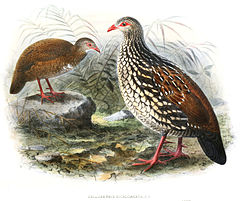Galloperdix
Wygląd
| Galloperdix[1] | |||
| Blyth, 1845[2] | |||
 Przedstawiciel rodzaju – kuropatwiak cejloński (G. bicalcarata) | |||
| Systematyka | |||
| Domena | |||
|---|---|---|---|
| Królestwo | |||
| Typ | |||
| Podtyp | |||
| Gromada | |||
| Podgromada | |||
| Infragromada | |||
| Rząd | |||
| Rodzina | |||
| Podrodzina | |||
| Plemię | |||
| Rodzaj |
Galloperdix | ||
| Typ nomenklatoryczny | |||
|
Tetrao spadicea J.F. Gmelin, 1789 | |||
| Synonimy | |||
| |||
| Gatunki | |||
| |||
Galloperdix – rodzaj ptaków z podrodziny bażantów (Phasianinae) w rodzinie kurowatych (Phasianidae).
Zasięg występowania[edytuj | edytuj kod]
Rodzaj obejmuje gatunki występujące w Azji Południowej[5].
Morfologia[edytuj | edytuj kod]
Długość ciała 27–38 cm; masa ciała 226–454 g (samce są większe i cięższe od samic)[6].
Systematyka[edytuj | edytuj kod]
Etymologia[edytuj | edytuj kod]
- Galloperdix: zbitka wyrazowa nazw rodzajów: Gallus Brisson, 1760 (kur) oraz Perdix Brisson, 1760 (kuropatwa)[7].
- Hepburnia: David Hepburn (1788–1851) – ppłk British Army w Indiach[8]. Gatunek typowy: Perdix hardwickii J.E. Gray, 1829.
- Plectroperdix: gr. πληκτρον plēktron „ostroga koguta”; περδιξ perdix, περδικος perdikos „kuropatwa”[9]. Nowa nazwa dla Hepburnia.
Podział systematyczny[edytuj | edytuj kod]
Do rodzaju należą następujące gatunki[10]:
- Galloperdix spadicea – kuropatwiak rdzawy
- Galloperdix lunulata – kuropatwiak siwogłowy
- Galloperdix bicalcarata – kuropatwiak cejloński
Przypisy[edytuj | edytuj kod]
- ↑ Galloperdix, [w:] Integrated Taxonomic Information System (ang.).
- ↑ E. Blyth. „On the Leiotrichane Birds of the Subhemalayas,” by B.H. Hodgson, Esq.: with some additions and annotations, — a Synopsis of the Indian Pari, — and of the Indian Fringillidae. „The Journal of the Asiatic Society of Bengal”. Część 2. 13 (1844), s. 936, 1845. (ang.).
- ↑ H.G.L. Reichenbach: Avium systema naturale. Das natürliche system der vögel mit hundert tafeln grösstentheils original-abbildungen der bis jetzt entdecken fast zwölfhundert typischen formen. Vorlaüfer einer iconographie der arten der vögel aller welttheile. Dresden und Leipzig: Expedition der vollständigsten naturgeschichte, 1850, s. xxviii. (niem.).
- ↑ F. Heine & A. Reichenow: Nomenclator Musei Heineani Ornithologici; Verzeichniss der Vogel-Sammlung des Kgl. Oberamtmanns Ferdinand Heine. Berlin: R. Friedländer & Sohn, 1890, s. 293. (niem.).
- ↑ F. Gill, D. Donsker & P. Rasmussen (red.): Pheasants, partridges, francolins. IOC World Bird List (v10.2). [dostęp 2020-08-27]. (ang.).
- ↑ P.J.K. Mc Gowan: Family Phasianidae (Pheasants and Partridges). W: J. del Hoyo, A. Elliott & J. Sargatal: Handbook of the Birds of the World. Cz. 2: New World Vultures to Guineafowl. Barcelona: Lynx Edicions, 1994, s. 523. ISBN 84-87334-15-6. (ang.).
- ↑ Galloperdix, [w:] The Key to Scientific Names, J.A. Jobling (red.), [w:] Birds of the World, S.M. Billerman et al. (red.), Cornell Lab of Ornithology, Ithaca [dostęp 2022-01-12] (ang.).
- ↑ Hepburnia, [w:] The Key to Scientific Names, J.A. Jobling (red.), [w:] Birds of the World, S.M. Billerman et al. (red.), Cornell Lab of Ornithology, Ithaca [dostęp 2022-01-12] (ang.).
- ↑ Plectroperdix, [w:] The Key to Scientific Names, J.A. Jobling (red.), [w:] Birds of the World, S.M. Billerman et al. (red.), Cornell Lab of Ornithology, Ithaca [dostęp 2022-01-12] (ang.).
- ↑ Systematyka i nazwy polskie za: P. Mielczarek & M. Kuziemko: Plemię: Polyplectronini Blyth, 1852 (wersja 2020-07-21). [w:] Kompletna lista ptaków świata [on-line]. Instytut Nauk o Środowisku Uniwersytetu Jagiellońskiego. [dostęp 2020-08-27].
